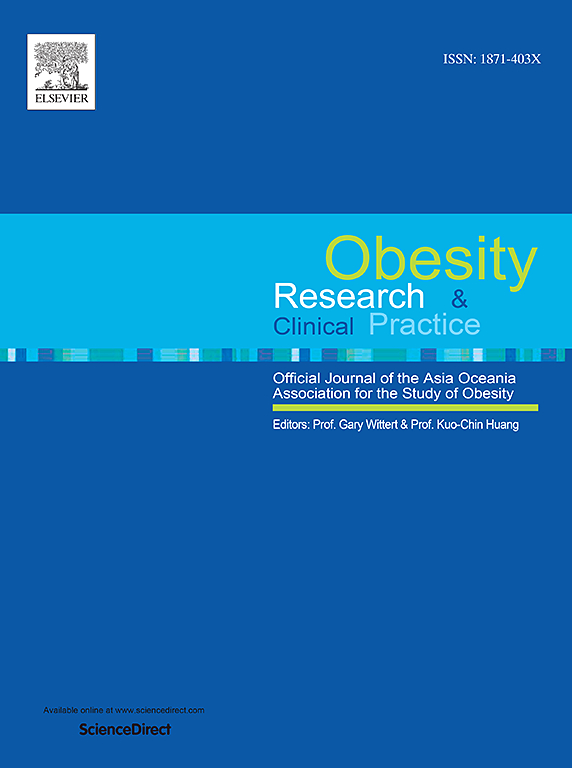Association between carotenoids and weight-adjusted waist index a cross-sectional study based on the national health and nutrition examination survey 2017–2018
IF 2.5
4区 医学
Q3 ENDOCRINOLOGY & METABOLISM
引用次数: 0
Abstract
Purpose
The weight-adjusted waist index (WWI) is a novel method for assessing abdominal obesity, offering greater accuracy than do body mass index and waist circumference in determining lean and fat mass. Carotenoids, known for their antioxidant properties, can effectively neutralize free radicals. We aimed to examine the relationship between serum carotenoid levels and WWI.
Methods
Data used in this study were obtained from the National Health and Nutrition Examination Survey between 2017 and 2018. Serum carotenoid levels were assessed via high-performance liquid chromatography. A multiple linear regression model was used to examine the correlation between serum carotenoid levels and WWI. Furthermore, potential nonlinear associations were identified using smooth curve fitting.
Principal results
In this population-based survey, 3829 participants were included. Multivariate linear regression analysis revealed that the highest serum carotenoid tertile was significantly associated with lower WWI values. The effect sizes (β) and 95 % confidence intervals were −0.31 (-0.37, −0.24), −0.37 (-0.43, −0.31), −0.24 (-0.31, −0.18), and −0.28 (-0.34, −0.21) for α-carotene, β-carotene, β-cryptoxanthin, and lutein/zeaxanthin, respectively. Smoothed curve fitting showed that β-carotene, β-cryptoxanthin, and lutein/zeaxanthin exhibited a nonlinear relationship with WWI.
Major conclusions
Several serum carotenoids were inversely associated with WWI in the general population of the United States, suggesting a potential protective role against abdominal obesity. However, further large-scale prospective studies are required to confirm these findings.
类胡萝卜素与体重调整腰围指数的相关性——基于2017-2018年全国健康与营养检查调查的横断面研究
目的:体重调整腰围指数(WWI)是一种评估腹部肥胖的新方法,在确定瘦脂肪质量方面比体重指数和腰围更准确。类胡萝卜素以其抗氧化特性而闻名,可以有效地中和自由基。我们旨在研究血清类胡萝卜素水平与第一次世界大战之间的关系。方法:本研究使用的数据来自2017 - 2018年全国健康与营养检查调查。采用高效液相色谱法测定血清类胡萝卜素水平。采用多元线性回归模型检验血清类胡萝卜素水平与一战的相关性。此外,使用光滑曲线拟合识别潜在的非线性关联。主要结果:本次以人群为基础的调查共纳入3829名参与者。多因素线性回归分析显示,血清类胡萝卜素含量越高,WWI值越低。α-胡萝卜素、β-胡萝卜素、β-隐黄质和叶黄素/玉米黄质的效应量(β)和95 %置信区间分别为-0.31(-0.37,-0.24)、-0.37(-0.43,-0.31)、-0.24(-0.31,-0.18)和-0.28(-0.34,-0.21)。光滑曲线拟合表明,β-胡萝卜素、β-隐黄质和叶黄素/玉米黄质与WWI呈非线性关系。主要结论:在美国普通人群中,几种血清类胡萝卜素与第一次世界大战呈负相关,表明对腹部肥胖具有潜在的保护作用。然而,需要进一步的大规模前瞻性研究来证实这些发现。
本文章由计算机程序翻译,如有差异,请以英文原文为准。
求助全文
约1分钟内获得全文
求助全文
来源期刊

Obesity research & clinical practice
医学-内分泌学与代谢
CiteScore
7.10
自引率
0.00%
发文量
80
审稿时长
49 days
期刊介绍:
The aim of Obesity Research & Clinical Practice (ORCP) is to publish high quality clinical and basic research relating to the epidemiology, mechanism, complications and treatment of obesity and the complication of obesity. Studies relating to the Asia Oceania region are particularly welcome, given the increasing burden of obesity in Asia Pacific, compounded by specific regional population-based and genetic issues, and the devastating personal and economic consequences. The journal aims to expose health care practitioners, clinical researchers, basic scientists, epidemiologists, and public health officials in the region to all areas of obesity research and practice. In addition to original research the ORCP publishes reviews, patient reports, short communications, and letters to the editor (including comments on published papers). The proceedings and abstracts of the Annual Meeting of the Asia Oceania Association for the Study of Obesity is published as a supplement each year.
 求助内容:
求助内容: 应助结果提醒方式:
应助结果提醒方式:


